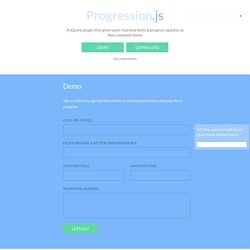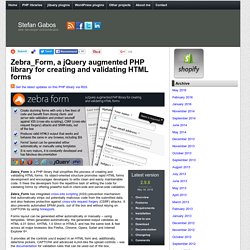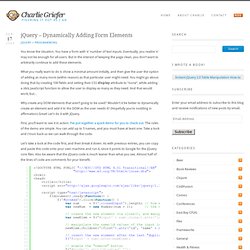

Progression.js. Documentation ..:: Getting Started Include the relevant files Firstly include jQuery and the progression.css and progress.js files.

Place these before </head> section Create a form You must give your form a unique ID. The helper text for the tooltip can be set by adding data-helper to the element. <form id="myform"><p><label for="">Name</label><input data-progression="" type="text" data-helper="Help users through forms by prividing helpful hinters" name="name" value="" placeholder="" /></p></form> Initiate the plugin Once you have created your form you will need to initiate the plugin.
At its most basic level you can initiate the plugin like: Maxatwork/form2js @ GitHub. Javascript library for collecting form data Example: If you have any questions/suggestions or find out something weird or illogical - feel free to post an issue.

Because everything is better with jQuery, jQuery plugin added, check out jquery.toObject.js =) Details Structure of resulting object defined by "name" attribute of form fields. This is not a serialization library. All this library doing is collecting form data and putting it in javascript object (obviously you can get JSON/XML/etc string by serializing it, but it's not an only purpose).
Usage var formData = form2object(rootNode, delimiter, skipEmpty, nodeCallback); or with jQuery plugin: var formData = $('form or form elements selector').toObject(options); Values of all inputs under the rootNode will be collected into one object (skipping empty inputs if skipEmpty not false). Expanding Search Bar Deconstructed. A tutorial on how to create a mobile-friendly and responsive expanding search bar.

View demo Download source Maybe you have noticed the little adjustments that we did to our theme lately here on Codrops. One of the things we thought might be nice to change is the search input. We’ve put it from the sidebar into the header and we use a common effect where you have to click to expand the input. We have received many requests on explaining how we did it and today we’d like to show you how to create a search input like that from scratch. Summarized, this is what we want the search component to do: Now that we know what we want to do, let’s start with the markup. The Markup For the markup we need a main container, a form, the text and submit inputs, and a span for the icon: Usually, we could use a pseudo-element for the icon, but because it’s not intended to be used on replaced elements like form elements, we will simply use a span in this case.
The CSS Now, let’s position the search input. Jlbruno/jQuery-Tristate-Checkbox-plugin @ GitHub. jQuery File Upload Demo. Lou.github.io/switchy/ Lou/switchy. Goker / droparea. Zebra_Form, a jQuery augmented PHP library for creating and validating HTML forms. Get the latest updates on this PHP library via RSS Zebra_Form is a PHP library that simplifies the process of creating and validating HTML forms.

Its object-oriented structure promotes rapid HTML forms development and encourages developers to write clean and easily maintainable code. It frees the developers from the repetitive task of writing the code for validating forms by offering powerful built-in client-side and server-side validation. Zebra_Form has integrated cross-site scripting (XSS) prevention mechanism that automatically strips out potentially malicious code from the submitted data, and also features protection against cross-site request forgery (CSRF) attacks. It also prevents automated SPAM posts, out of the box and without relying on CAPTCHA by using honeypots. Forms layout can be generated either automatically or manually – using templates. The client-side validation is done using jQuery 1.5.2+ Features review Requirements jQuery 1.5.2+ Installation How to use Live demos The HTML. jQuery – Dynamically Adding Form Elements @ Charlie Griefer. You know the situation.

You have a form with ‘x’ number of text inputs. Eventually, you realize ‘x’ may not be enough for all users. But in the interest of keeping the page clean, you don’t want to arbitrarily continue to add these elements. What you really want to do is show a minimal amount initially, and then give the user the option of adding as many more (within reason) as that particular user might need.
You might go about doing that by creating 100 fields and setting their CSS display attribute to “none”, while adding a slick JavaScript function to allow the user to display as many as they need. Why create any DOM elements that aren’t going to be used? First, you’ll want to see it in action. Let’s take a look at the code first, and then break it down. The Markup Let’s look at what’s going on, starting with the form itself: Very straightforward markup. Next up is another div that holds 2 button elements, each with a unique id attribute. Super customized checkboxes and radio buttons with jQuery.